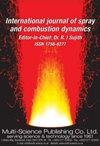Excitation of the precessing vortex core by active flow control to suppress thermoacoustic instabilities in swirl flames
IF 2.1
4区 工程技术
Q3 ENGINEERING, MECHANICAL
International Journal of Spray and Combustion Dynamics
Pub Date : 2019-01-01
DOI:10.1177/1756827719856237
引用次数: 14
Abstract
In this study, we apply periodic flow excitation of the precessing vortex core at the centerbody of a swirl-stabilized combustor to investigate the impact of the precessing vortex core on flame shape, flame dynamics, and especially thermoacoustic instabilities. The current control scheme is based on results from linear stability theory that determine the precessing vortex core as a global hydrodynamic instability with its maximum receptivity to open-loop actuation located near the center of the combustor inlet. The control concept is first validated at isothermal conditions. This is of utmost importance for the proceeding studies that focus on the exclusive impact of the precessing vortex core on the combustion dynamics. Subsequently, the control is applied to reacting conditions considering lean premixed turbulent swirl flames. Considering thermoacoustically stable flames first, it is shown that the actuation locks onto the precessing vortex core when it is naturally present in the flame, which allows the precessing vortex core frequency to be controlled. Moreover, the control allows the precessing vortex core to be excited in conditions where it is naturally suppressed by the flame, which yields a very effective possibility to control the precessing vortex core amplitude. The control is then applied to thermoacoustically unstable conditions. Considering perfectly premixed flames first, it is shown that the precessing vortex core actuation has only a minor effect on the thermoacoustic oscillation amplitude. However, we observe a continuous increase of the thermoacoustic frequency with increasing precessing vortex core amplitude due to an upstream displacement of the mean flame and resulting reduction of the convective time delay. Considering partially premixed flames, the precessing vortex core actuation shows a dramatic reduction of the thermoacoustic oscillation amplitude. In consideration of the perfectly premixed cases, we suspect that this is caused by the precessing vortex core-enhanced mixing of equivalence ratio fluctuations at the flame root and due to a reduction of time delays due to mean flame displacement.用主动流动控制激励旋进涡核以抑制涡流火焰中的热声不稳定性
在这项研究中,我们在涡流稳定燃烧器的中心体处应用进动涡核的周期性流动激励,以研究进动涡核心对火焰形状、火焰动力学,特别是热声不稳定性的影响。当前的控制方案基于线性稳定性理论的结果,该理论将进动涡核确定为全局流体动力学不稳定性,其对位于燃烧器入口中心附近的开环致动的最大可接受性。控制概念首先在等温条件下得到验证。这对于正在进行的专注于旋进涡核对燃烧动力学的排他性影响的研究至关重要。随后,将该控制应用于考虑贫预混湍流旋流火焰的反应条件。首先考虑热声稳定的火焰,结果表明,当进动涡核自然存在于火焰中时,驱动锁定在进动涡核心上,从而可以控制进动涡芯的频率。此外,该控制允许进动涡核在其被火焰自然抑制的条件下被激励,这产生了控制进动涡核心振幅的非常有效的可能性。然后将该控制应用于热声不稳定的条件。首先考虑完全预混火焰,结果表明旋进涡核驱动对热声振荡振幅的影响很小。然而,我们观察到,由于平均火焰的上游位移和对流时间延迟的减少,热声频率随着旋进涡核振幅的增加而持续增加。考虑到部分预混火焰,进动涡核驱动显示出热声振荡振幅的显著降低。考虑到完全预混的情况,我们怀疑这是由于进动涡核增强了火焰根部当量比波动的混合,以及由于平均火焰位移导致的时间延迟减少。
本文章由计算机程序翻译,如有差异,请以英文原文为准。
求助全文
约1分钟内获得全文
求助全文
来源期刊

International Journal of Spray and Combustion Dynamics
THERMODYNAMICS-ENGINEERING, MECHANICAL
CiteScore
2.20
自引率
12.50%
发文量
21
审稿时长
>12 weeks
期刊介绍:
International Journal of Spray and Combustion Dynamics is a peer-reviewed open access journal on fundamental and applied research in combustion and spray dynamics. Fundamental topics include advances in understanding unsteady combustion, combustion instability and noise, flame-acoustic interaction and its active and passive control, duct acoustics...
 求助内容:
求助内容: 应助结果提醒方式:
应助结果提醒方式:


